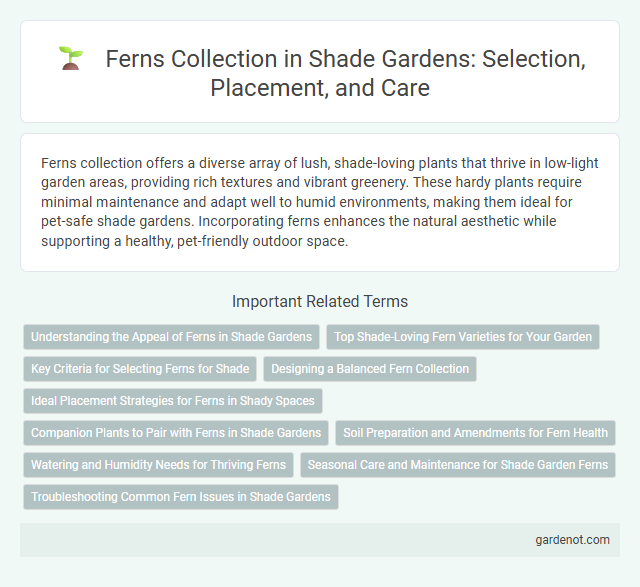Ferns collection offers a diverse array of lush, shade-loving plants that thrive in low-light garden areas, providing rich textures and vibrant greenery. These hardy plants require minimal maintenance and adapt well to humid environments, making them ideal for pet-safe shade gardens. Incorporating ferns enhances the natural aesthetic while supporting a healthy, pet-friendly outdoor space.
Understanding the Appeal of Ferns in Shade Gardens
Ferns thrive in shade gardens due to their ability to flourish in low-light, moist environments, making them ideal for under-canopy planting. Their lush, textured fronds offer year-round greenery and a natural, calming aesthetic that enhances garden biodiversity. Popular fern species such as the Japanese Painted Fern, Maidenhair Fern, and Lady Fern provide diverse foliage shapes and colors, adding visual interest and depth to shaded outdoor spaces.
Top Shade-Loving Fern Varieties for Your Garden
Top shade-loving fern varieties for your garden include the Maidenhair Fern (Adiantum), known for its delicate, fan-shaped fronds that thrive in low light and moist soil. The Japanese Painted Fern (Athyrium niponicum) offers striking silver and burgundy foliage, adding texture and color to shaded garden beds. The Christmas Fern (Polystichum acrostichoides) remains evergreen in mild climates, providing year-round greenery and excellent ground cover in dense shade.
Key Criteria for Selecting Ferns for Shade
Selecting ferns for shade gardens involves prioritizing species with high shade tolerance, such as Dryopteris, Polystichum, and Athyrium, which thrive in low-light conditions. Soil moisture retention and drainage are crucial key criteria, as most ferns prefer consistently moist, well-drained soil rich in organic matter. Choosing fern varieties with diverse frond textures and growth habits enhances visual interest while ensuring adaptability to varying shade intensities and microclimates within the garden.
Designing a Balanced Fern Collection
Designing a balanced fern collection for a shade garden involves selecting a variety of species that offer diverse textures, frond shapes, and shades of green to create visual interest throughout the year. Incorporate hardy ferns such as Dryopteris erythrosora and Athyrium niponicum alongside delicate options like Adiantum pedatum to ensure a dynamic yet cohesive display. Proper spacing and layering these ferns according to their mature size and growth habit enhances depth and maintains healthy airflow in the shaded environment.
Ideal Placement Strategies for Ferns in Shady Spaces
Ferns thrive in consistently moist, well-drained soil and prefer locations with dappled sunlight or deep shade, making them ideal candidates for shaded garden beds, under tree canopies, or along shaded walkways. Grouping ferns with other shade-loving plants like hostas and astilbes enhances the natural woodland aesthetic while maintaining humidity levels beneficial for their growth. Strategic placement near water features or in areas protected from strong winds ensures optimal humidity and minimizes leaf desiccation, promoting lush, vibrant foliage throughout the growing season.
Companion Plants to Pair with Ferns in Shade Gardens
Ferns thrive in shaded, moist environments and pair well with companion plants like hostas, astilbes, and heucheras, which complement their delicate fronds with contrasting textures and colors. Shade-loving shrubs such as hydrangeas and rhododendrons provide structural interest while maintaining the cool, humid conditions ferns require. Groundcovers like ajuga and vinca minor help retain soil moisture and suppress weeds, enhancing the overall health and aesthetic of a fern-focused shade garden.
Soil Preparation and Amendments for Fern Health
Ferns thrive in rich, well-draining soil with high organic matter content, making soil preparation crucial for optimal health. Incorporate ample compost or leaf mold to enhance moisture retention and provide essential nutrients, ensuring a slightly acidic pH between 5.5 and 6.5. Regularly amend the soil with organic mulches like pine needles or bark to maintain humidity and protect delicate fern roots from temperature fluctuations.
Watering and Humidity Needs for Thriving Ferns
Ferns in a shade garden require consistently moist soil and thrive best in high humidity environments, typically between 50-70%. Regular watering should ensure the soil remains damp but not waterlogged, as prolonged dryness can cause frond browning and stress. Incorporating mulch and misting the foliage can help maintain optimal moisture levels and support healthy fern growth.
Seasonal Care and Maintenance for Shade Garden Ferns
Shade garden ferns thrive with consistent moisture and well-drained, rich organic soil to maintain their lush foliage across seasons. In spring, remove dead fronds and apply a balanced slow-release fertilizer to encourage new growth. During summer, increase watering frequency to prevent drying, while in fall, reduce watering and mulch to insulate roots for winter dormancy.
Troubleshooting Common Fern Issues in Shade Gardens
Ferns in shade gardens often face issues like yellowing fronds, caused by overwatering or poor drainage, and browning tips, commonly due to low humidity or inconsistent watering. To troubleshoot these problems, ensure well-draining soil, maintain consistent moisture without waterlogging, and increase humidity with misting or a humidifier. Monitoring for pests such as scale and aphids can prevent further stress on ferns, promoting healthy growth in shaded environments.
Ferns collection Infographic

 gardenot.com
gardenot.com